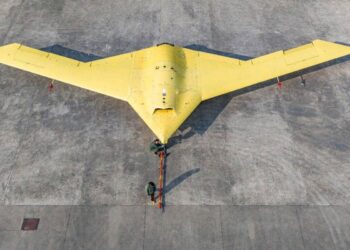BEIJING (Realist English). Chinese aerospace engineers have revealed what they claim is the world’s first jet-powered vertical take-off and landing (VTOL) drone, a technology that could allow ordinary warships to operate high-speed, long-range aircraft without runways or carriers.
Developed over a decade by associate professors Wang Yaokun and Qiu Yuting at Beijing’s Beihang University, the sleek, runway-independent drone combines vertical lift with jet-propelled cruise in a single aerodynamic frame. Unlike the US XQ-58A Valkyrie, which requires long runways or carrier decks, the Chinese platform can lift off vertically in rough seas, transition smoothly into forward flight, and land on compact ship decks.
The design uses compact electric rotors for take-off and landing, paired with a miniature turbojet for high-speed cruise. A patented retractable fairing encloses the rotors after transition, reducing drag by up to 60% and giving the fuselage a streamlined, teardrop profile. The airframe is made from advanced T-700 carbon fibre composites reinforced with modified resin matrices for light weight, strength, and heat resistance up to 700°C in the engine exhaust zone.
Flight tests showed a 45kg prototype achieving 230 km/h with stable mode transitions. The drone was conceived specifically for “non-carrier vessels” to perform high-speed reconnaissance, coordinated multi-drone operations, and vertical launch from destroyer decks.
If deployed at scale, Chinese destroyers, frigates, and amphibious vessels could act as mobile drone bases, launching swarms for surveillance or precision strikes without relying on fixed airfields. Analysts say such a network could extend China’s reach deep into the Pacific and Indian oceans, supporting maritime blockades, island chain operations, or crisis response.
“This turns every major surface combatant into a forward-operating base,” said a Chinese defence technology expert. “The enemy can’t predict where the next strike will come from.”
However, the hybrid design comes with trade-offs: during cruise, the idle rotor system adds weight and reduces payload capacity; during vertical flight, the turbojet remains inactive, further limiting efficiency. Experts suggest the drone is best suited for reconnaissance, electronic warfare, or small precision munitions rather than heavy ordnance.
Despite these constraints, the breakthrough offers a potential game-changer in distributed naval air power, enabling China to project force from a far wider range of platforms than conventional carrier-based aviation allows.


















